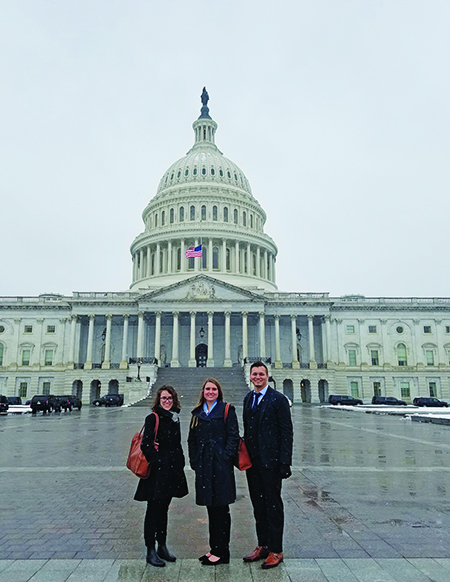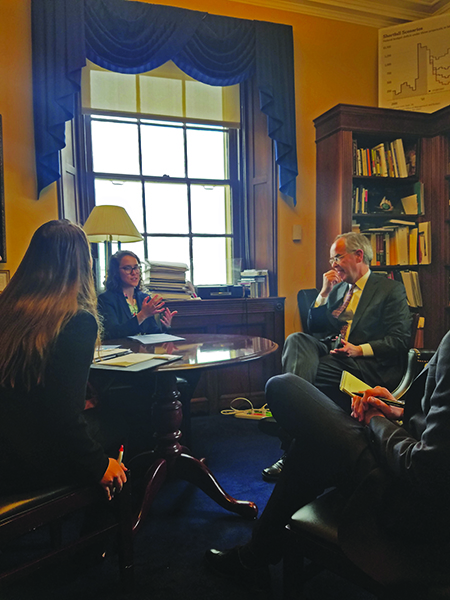Science Policy in Congress: A Physics Problem Where the Laws of Physics Don’t Apply
Science Policy in Congress: A Physics Problem Where the Laws of Physics Don’t Apply
As a physics student, I am more comfortable studying the laws of physics than the laws of the United States government. If I wanted the path of least resistance, though, I wouldn’t have gone into physics. When the opportunity came up through the Society of Physics Students Congressional Visits Day to go to Washington, DC, meet US representatives and their staff, and talk about science policy, as both a researcher and science advocate I had to go.
I am a double major in physics and applied mathematics who is minoring in international studies at North Carolina State University. As the secretary of the active SPS chapter at my school, I’ve helped my chapter grow and participate in events like the March for Science and outreach activities.
My goal in attending the SPS Congressional Visits Day (CVD) was to discuss US immigration policy as it relates to those I know in the sciences. I have had labmates and professors from all over the world. Scientists based in the United States collaborate with people in many different countries, and our science and innovation is better because of the mix of collaboration and competition.
SPS made sure we (the five of us students participating in SPS CVD) didn’t just wander into congressional offices without any preparation. Beforehand, they connected us with professional advocates who had PhDs in physics and were working in Washington, trying to use their physics background to make change. The five of us were interested in discussing policy related to physics education, energy research, science funding, and immigration. Our interests were as varied as the places we came from (North Carolina to Alaska), so we had a lot to talk about. During the training, we learned about crafting our message, how laws are drafted, and all the factors congressional representatives need to keep in mind while making decisions.
Then came the day we got to visit Congress! And it snowed… DC was shut down and many offices called in to cancel appointments. Needless to say, it wasn’t a surprise to get a text at 7:11 a.m. that North Carolina Senator Richard Burr and North Carolina House Representative Walter B. Jones had to cancel due to snow. We were lucky that a handful of offices stayed open to meet with us.
We started the morning with a Constituent Meet-and-Greet. At these events, representatives meet with voters in their states and announce what they are currently working on, list any big concerns, and listen to the concerns of everyone who made it there that morning. From there, we moved on to our meetings with different offices.
In most of the meetings, we weren’t actually meeting with the senators or representatives themselves but their staffers. The staffers we met with were all pretty young, recently out of college and in charge of collecting information related to how bills should be written and what the congressional representatives should know before they vote. (Basically, Congress is being run by a bunch of people in their twenties!) These are people who have to keep up with dozens of different issues at the same time.
Our group of students attended the meetings together. In each meeting, we let the student whose state was represented run the meeting and choose the topic to discuss. As a physics student from eastern North Carolina, I’ve had my share of experiences related to lack of physics education at the K-12 level, the need for better energy research, and the need for science funding, so it was easy to give supporting evidence in the meetings run by other students.
My big meeting was with North Carolina Senator Thom Tillis’s staffer Andrew Nam. As it turns out, Andrew attended both universities that I spend time at: North Carolina State University and University of North Carolina at Chapel Hill. Between this connection and the fact he wasn’t much older than I am, we had a very comfortable conversation. It was Andrew’s job to highlight what Senator Tillis is currently working toward accomplishing and both listen to me and present Senator Tillis’s stances.
It was an interesting dynamic. I came to talk about how the complexities of immigration and visas were costing academic institutions and businesses millions and slowing down US advancement and innovation. It’s impossible for someone to change visa status without the aid and expense of an immigration lawyer, regardless of the reason why. Senator Tillis is currently working on an immigration bill related to DACA called the Solution for Undocumented Children through Careers, Employment, Education and Defending our Nation (SUCCEED) Act (S. 1852). While this potential law provides a path for the currently uncertain future of DACA participants to attain permanent legal status, it’s a 10–15-year path that, in its current form, is pretty strict. My friend David, who has been a part of DACA for the last five or so years, worries that he will be well into his thirties by the time he could change his immigration status. Such an uncertain future is pretty scary.
The experience of talking with Andrew helped me realize that regardless of what my goals may be, different offices will have different priorities. Thus, my message is one that will have to be repeated often.
Overall, through SPS CVD I learned that Congress is much more complicated than I’ve been taught, just as physics is much more complicated than a freshman physics class makes it seem. Advocating for the things we care about may not seem easy, but it is something we all can do. Science policy is something that needs to be talked about again and again for us to make a sustained difference, and all that talking sounds like great practice that will only make us better at sharing our message.
Physics students are not afraid of a challenge, so I dare you to take a step toward improving science policy. Start by doing some online research or talking about it with your fellow students and go from there. Good luck!
The SPS Congressional Visits Day (SPS CVD) is a program that supports student engagement in science policy and advocacy on Capitol Hill. During the two-day program, SPS members come to Washington, DC, to meet with members of Capitol Hill and their staff to engage with them and advocate for science policy issues. These interactions are an important and effective opportunity for those members interested in science policy and communication. The following articles provide two of the 2018 SPS CVD participants’ perspectives about their visits, the topics they discussed, and lessons learned.
You can find out more about the SPS Congressional Visits Day here: http://www.spsnational.org/programs/sps-cvd.


